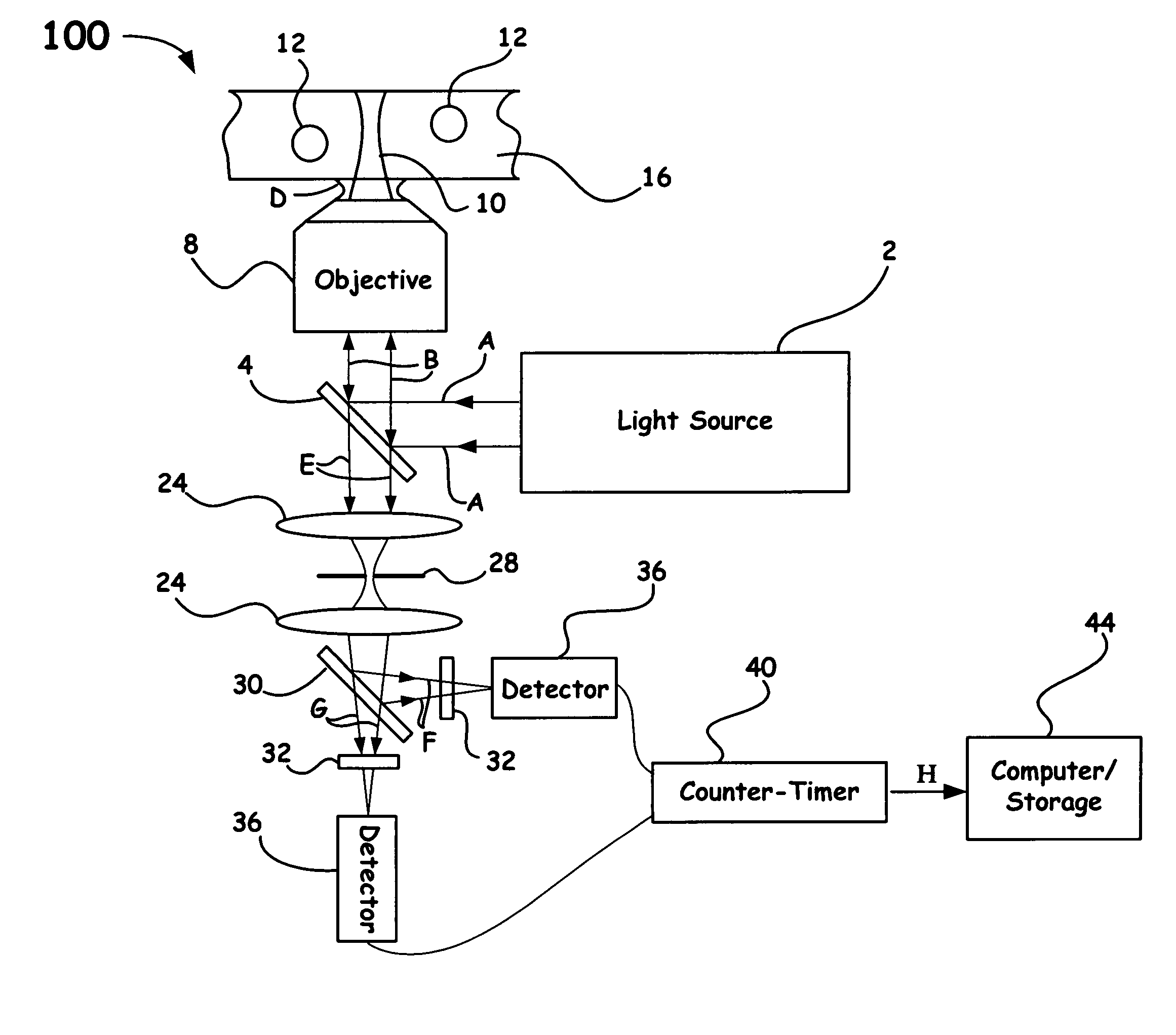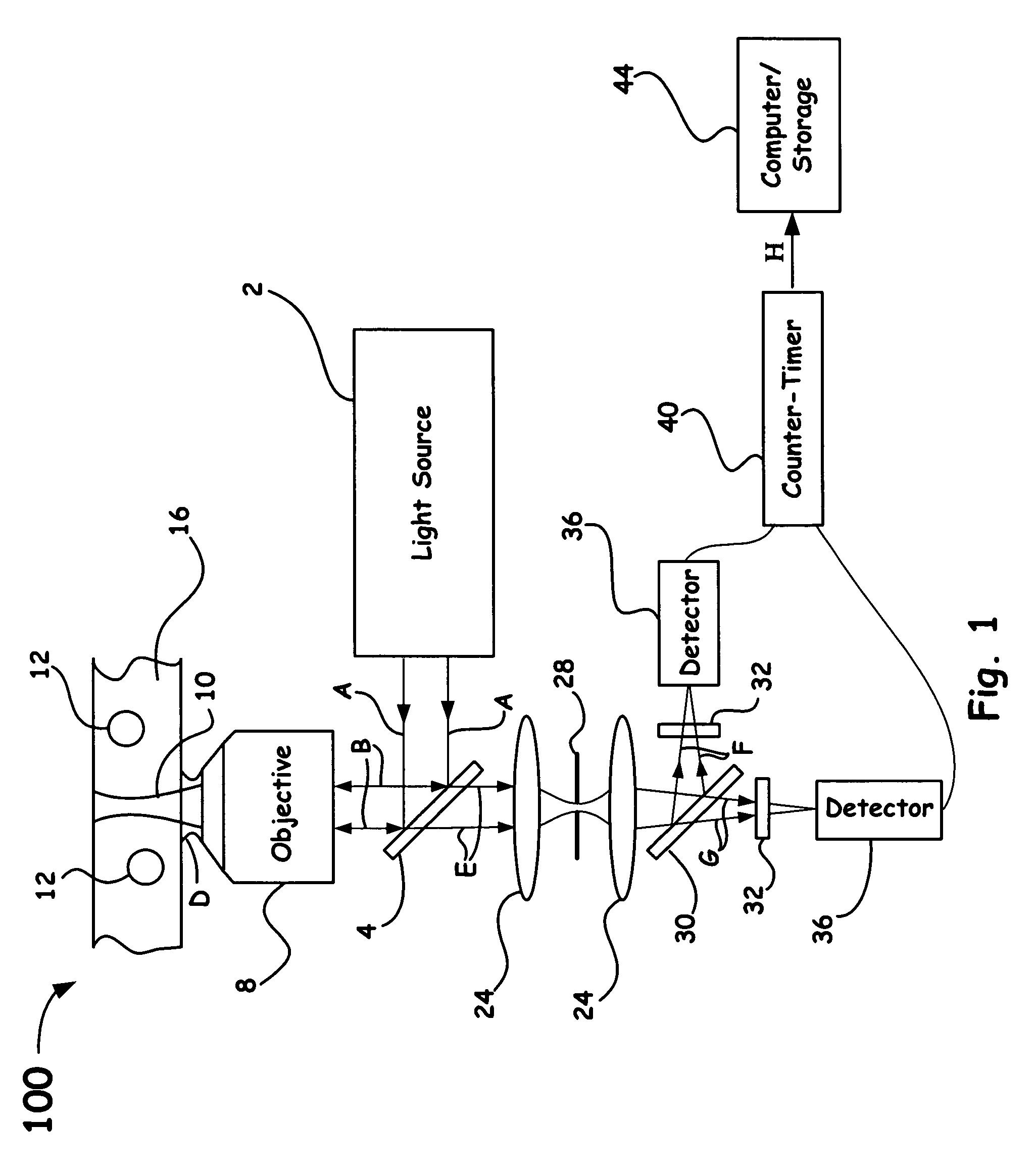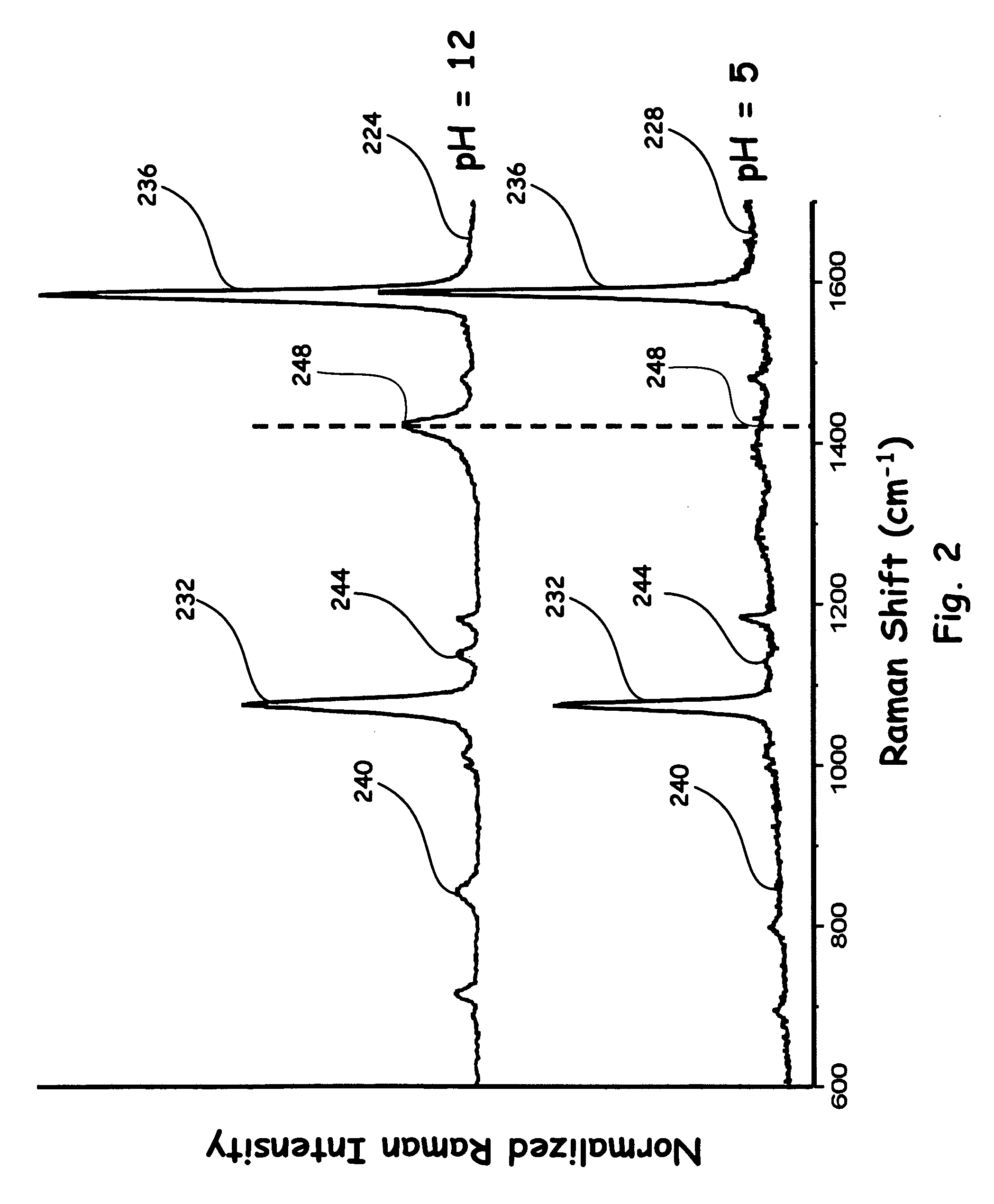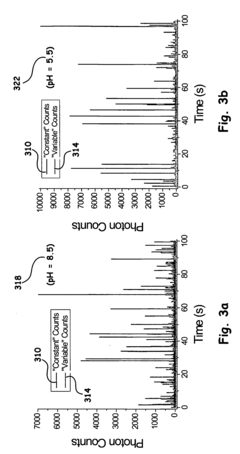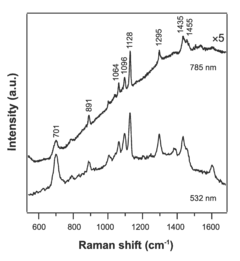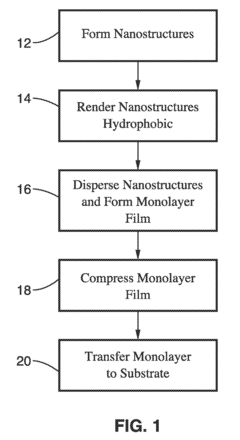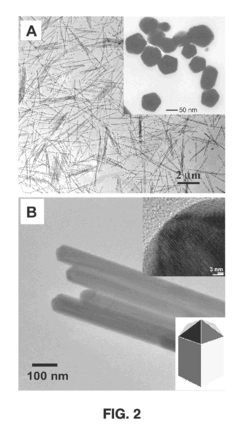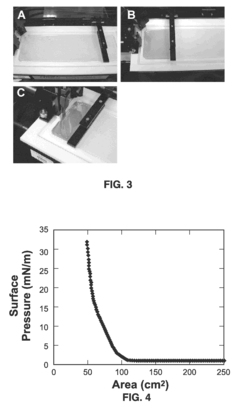SERS Substrates in Wireless Sensor Network Technologies
OCT 11, 20259 MIN READ
Generate Your Research Report Instantly with AI Agent
Patsnap Eureka helps you evaluate technical feasibility & market potential.
SERS Substrate Evolution and Research Objectives
Surface-Enhanced Raman Spectroscopy (SERS) has evolved significantly since its discovery in the 1970s, transforming from a laboratory curiosity to a powerful analytical technique with diverse applications. The initial observation of enhanced Raman signals on roughened silver electrodes by Fleischmann, Hendra, and McQuillan in 1974 marked the beginning of this revolutionary technology. Subsequent theoretical explanations by Jeanmaire and Van Duyne in 1977 established the electromagnetic enhancement mechanism, while Albrecht and Creighton proposed the chemical enhancement theory, laying the foundation for SERS substrate development.
Early SERS substrates primarily consisted of electrochemically roughened metal surfaces with limited reproducibility and enhancement factors. The 1990s witnessed significant advancements with the introduction of colloidal nanoparticles, offering improved control over surface morphology. The 2000s brought nanofabrication techniques that enabled precise engineering of SERS-active structures, including nanolithography-produced arrays and self-assembled monolayers.
Recent developments have focused on creating highly sensitive, reproducible, and stable SERS substrates suitable for field deployment in wireless sensor networks (WSNs). These advanced substrates incorporate noble metal nanostructures with optimized geometries to maximize electromagnetic field enhancement at "hot spots." Hierarchical structures combining micro and nano features have emerged as particularly promising for environmental and biological sensing applications.
The integration of SERS substrates with WSN technologies represents a convergence of analytical chemistry and IoT infrastructure, offering unprecedented capabilities for remote, real-time molecular detection. This integration aims to overcome traditional limitations of laboratory-based spectroscopic techniques by enabling distributed sensing networks capable of continuous environmental monitoring, threat detection, and biomedical diagnostics.
Our research objectives focus on developing next-generation SERS substrates specifically designed for WSN implementation. We aim to create substrates that maintain high enhancement factors while addressing key requirements for field deployment: environmental stability, reproducibility, cost-effectiveness, and compatibility with miniaturized spectrometers. Additionally, we seek to optimize power consumption and signal processing algorithms to enable efficient wireless transmission of spectral data.
The ultimate goal is to establish a technological framework for SERS-enabled wireless sensor networks capable of detecting trace contaminants, biological agents, and chemical threats in diverse environments. This research will explore novel substrate materials, including flexible polymers with embedded nanostructures, self-cleaning surfaces to prevent fouling, and stimuli-responsive substrates that can be remotely activated. By advancing SERS substrate technology specifically for WSN applications, we aim to enable transformative capabilities in environmental monitoring, public safety, and healthcare diagnostics.
Early SERS substrates primarily consisted of electrochemically roughened metal surfaces with limited reproducibility and enhancement factors. The 1990s witnessed significant advancements with the introduction of colloidal nanoparticles, offering improved control over surface morphology. The 2000s brought nanofabrication techniques that enabled precise engineering of SERS-active structures, including nanolithography-produced arrays and self-assembled monolayers.
Recent developments have focused on creating highly sensitive, reproducible, and stable SERS substrates suitable for field deployment in wireless sensor networks (WSNs). These advanced substrates incorporate noble metal nanostructures with optimized geometries to maximize electromagnetic field enhancement at "hot spots." Hierarchical structures combining micro and nano features have emerged as particularly promising for environmental and biological sensing applications.
The integration of SERS substrates with WSN technologies represents a convergence of analytical chemistry and IoT infrastructure, offering unprecedented capabilities for remote, real-time molecular detection. This integration aims to overcome traditional limitations of laboratory-based spectroscopic techniques by enabling distributed sensing networks capable of continuous environmental monitoring, threat detection, and biomedical diagnostics.
Our research objectives focus on developing next-generation SERS substrates specifically designed for WSN implementation. We aim to create substrates that maintain high enhancement factors while addressing key requirements for field deployment: environmental stability, reproducibility, cost-effectiveness, and compatibility with miniaturized spectrometers. Additionally, we seek to optimize power consumption and signal processing algorithms to enable efficient wireless transmission of spectral data.
The ultimate goal is to establish a technological framework for SERS-enabled wireless sensor networks capable of detecting trace contaminants, biological agents, and chemical threats in diverse environments. This research will explore novel substrate materials, including flexible polymers with embedded nanostructures, self-cleaning surfaces to prevent fouling, and stimuli-responsive substrates that can be remotely activated. By advancing SERS substrate technology specifically for WSN applications, we aim to enable transformative capabilities in environmental monitoring, public safety, and healthcare diagnostics.
Market Analysis for SERS-Enhanced Wireless Sensing
The global market for SERS-enhanced wireless sensing technologies is experiencing significant growth, driven by increasing demand for advanced detection capabilities across multiple industries. The current market size for SERS substrates in wireless sensor applications is estimated at $2.3 billion, with projections indicating a compound annual growth rate of 18.7% through 2028. This growth trajectory is substantially higher than the broader sensor market, which grows at approximately 7-9% annually.
Healthcare and biomedical applications represent the largest market segment, accounting for approximately 42% of the total market share. The ability of SERS-enhanced sensors to detect biomarkers at ultra-low concentrations has created substantial demand in clinical diagnostics, drug discovery, and personalized medicine. Environmental monitoring constitutes the second-largest segment at 27%, where these sensors enable real-time detection of pollutants, pathogens, and chemical agents at concentrations previously undetectable with conventional wireless sensing technologies.
Food safety and quality control applications have emerged as the fastest-growing segment, expanding at 23.5% annually. This growth is primarily driven by increasing regulatory requirements and consumer demand for contamination-free products. The industrial sector, particularly in chemical processing and manufacturing, represents 18% of the market, utilizing SERS-enhanced wireless sensors for process monitoring and quality control.
Geographically, North America leads the market with 38% share, followed by Europe (29%) and Asia-Pacific (26%). However, the Asia-Pacific region is experiencing the most rapid growth at 22.3% annually, primarily due to increasing industrial automation and healthcare infrastructure development in China, Japan, and South Korea.
Key market drivers include the miniaturization of sensing devices, integration with IoT platforms, and decreasing production costs of SERS substrates. The average cost per SERS substrate has decreased by 35% over the past five years, making implementation more economically viable across various applications. Additionally, regulatory pressures for more sensitive environmental monitoring and stricter quality control standards are accelerating adoption.
Market challenges include standardization issues, reliability concerns in field conditions, and competition from alternative sensing technologies. The relatively high initial investment required for SERS-enhanced wireless sensor networks remains a barrier for small and medium enterprises, though this is gradually being addressed through more cost-effective manufacturing techniques and economies of scale.
Healthcare and biomedical applications represent the largest market segment, accounting for approximately 42% of the total market share. The ability of SERS-enhanced sensors to detect biomarkers at ultra-low concentrations has created substantial demand in clinical diagnostics, drug discovery, and personalized medicine. Environmental monitoring constitutes the second-largest segment at 27%, where these sensors enable real-time detection of pollutants, pathogens, and chemical agents at concentrations previously undetectable with conventional wireless sensing technologies.
Food safety and quality control applications have emerged as the fastest-growing segment, expanding at 23.5% annually. This growth is primarily driven by increasing regulatory requirements and consumer demand for contamination-free products. The industrial sector, particularly in chemical processing and manufacturing, represents 18% of the market, utilizing SERS-enhanced wireless sensors for process monitoring and quality control.
Geographically, North America leads the market with 38% share, followed by Europe (29%) and Asia-Pacific (26%). However, the Asia-Pacific region is experiencing the most rapid growth at 22.3% annually, primarily due to increasing industrial automation and healthcare infrastructure development in China, Japan, and South Korea.
Key market drivers include the miniaturization of sensing devices, integration with IoT platforms, and decreasing production costs of SERS substrates. The average cost per SERS substrate has decreased by 35% over the past five years, making implementation more economically viable across various applications. Additionally, regulatory pressures for more sensitive environmental monitoring and stricter quality control standards are accelerating adoption.
Market challenges include standardization issues, reliability concerns in field conditions, and competition from alternative sensing technologies. The relatively high initial investment required for SERS-enhanced wireless sensor networks remains a barrier for small and medium enterprises, though this is gradually being addressed through more cost-effective manufacturing techniques and economies of scale.
Current SERS Substrate Technologies and Limitations
Surface-Enhanced Raman Spectroscopy (SERS) substrates have evolved significantly over the past decades, with current technologies broadly categorized into three main types: metallic nanoparticle-based, nanopatterned solid surfaces, and flexible/composite substrates. Each category presents unique advantages and limitations when integrated into wireless sensor network (WSN) applications.
Metallic nanoparticle-based substrates, typically utilizing gold or silver colloids, offer high enhancement factors (10^6-10^8) and relatively simple preparation methods. However, they suffer from poor reproducibility, limited shelf life, and challenges in maintaining consistent hot spot distribution. When deployed in WSN environments, these substrates often experience degradation due to environmental exposure, leading to signal inconsistency over time.
Nanopatterned solid surfaces, including lithographically fabricated arrays and etched silicon structures coated with noble metals, provide better reproducibility and stability compared to colloidal systems. These substrates demonstrate enhancement factors of 10^5-10^7 with improved spatial uniformity. The primary limitations include high manufacturing costs, complex fabrication processes requiring specialized equipment, and reduced flexibility for integration into diverse sensor form factors necessary for WSN deployment.
Flexible and composite SERS substrates, emerging as promising candidates for WSN integration, incorporate SERS-active materials onto polymeric or paper-based platforms. While offering advantages in conformability and adaptability to various sensing environments, these substrates typically exhibit lower enhancement factors (10^4-10^6) and face challenges in maintaining structural integrity under environmental stress.
A significant limitation across all current SERS substrate technologies for WSN applications is power consumption. The optical components required for Raman signal acquisition demand substantial energy, conflicting with the low-power requirements of remote WSN nodes. Additionally, most existing substrates lack selectivity toward specific analytes, necessitating additional functionalization steps that complicate manufacturing and potentially reduce shelf life.
Signal processing represents another critical challenge. The complex spectral data generated by SERS substrates requires sophisticated algorithms for interpretation, increasing computational demands on WSN nodes. Current substrates also demonstrate limited multiplexing capabilities, restricting the simultaneous detection of multiple analytes in complex environmental matrices.
Miniaturization constraints further complicate SERS substrate integration into WSN technologies. Many high-performance substrates require precise optical alignment and specific excitation conditions that are difficult to maintain in compact, field-deployable sensor packages. The trade-off between miniaturization and performance remains a significant technological barrier.
Metallic nanoparticle-based substrates, typically utilizing gold or silver colloids, offer high enhancement factors (10^6-10^8) and relatively simple preparation methods. However, they suffer from poor reproducibility, limited shelf life, and challenges in maintaining consistent hot spot distribution. When deployed in WSN environments, these substrates often experience degradation due to environmental exposure, leading to signal inconsistency over time.
Nanopatterned solid surfaces, including lithographically fabricated arrays and etched silicon structures coated with noble metals, provide better reproducibility and stability compared to colloidal systems. These substrates demonstrate enhancement factors of 10^5-10^7 with improved spatial uniformity. The primary limitations include high manufacturing costs, complex fabrication processes requiring specialized equipment, and reduced flexibility for integration into diverse sensor form factors necessary for WSN deployment.
Flexible and composite SERS substrates, emerging as promising candidates for WSN integration, incorporate SERS-active materials onto polymeric or paper-based platforms. While offering advantages in conformability and adaptability to various sensing environments, these substrates typically exhibit lower enhancement factors (10^4-10^6) and face challenges in maintaining structural integrity under environmental stress.
A significant limitation across all current SERS substrate technologies for WSN applications is power consumption. The optical components required for Raman signal acquisition demand substantial energy, conflicting with the low-power requirements of remote WSN nodes. Additionally, most existing substrates lack selectivity toward specific analytes, necessitating additional functionalization steps that complicate manufacturing and potentially reduce shelf life.
Signal processing represents another critical challenge. The complex spectral data generated by SERS substrates requires sophisticated algorithms for interpretation, increasing computational demands on WSN nodes. Current substrates also demonstrate limited multiplexing capabilities, restricting the simultaneous detection of multiple analytes in complex environmental matrices.
Miniaturization constraints further complicate SERS substrate integration into WSN technologies. Many high-performance substrates require precise optical alignment and specific excitation conditions that are difficult to maintain in compact, field-deployable sensor packages. The trade-off between miniaturization and performance remains a significant technological barrier.
Current SERS Integration Solutions for WSN
01 Metallic nanostructured SERS substrates
Metallic nanostructured surfaces are widely used as SERS substrates due to their ability to enhance Raman signals through plasmonic effects. These substrates typically consist of noble metals like gold, silver, or copper arranged in specific patterns or structures such as nanoparticles, nanorods, or nanogaps. The size, shape, and spacing of these metallic nanostructures can be optimized to achieve maximum enhancement factors, enabling detection of analytes at very low concentrations.- Metal nanostructure-based SERS substrates: Metal nanostructures, particularly those made of gold, silver, or copper, serve as effective SERS substrates due to their plasmonic properties. These substrates can be fabricated in various forms including nanoparticles, nanorods, and nanopatterned surfaces. The localized surface plasmon resonance generated by these metal nanostructures significantly enhances the Raman signal, allowing for highly sensitive molecular detection. The enhancement factor can reach several orders of magnitude, making these substrates suitable for trace analysis applications.
- Fabrication methods for SERS substrates: Various fabrication techniques are employed to create SERS substrates with optimized performance. These include lithographic methods, self-assembly processes, template-assisted growth, and chemical deposition approaches. Advanced nanofabrication techniques allow for precise control over the size, shape, and spacing of nanostructures, which are critical parameters affecting SERS enhancement. Some methods focus on creating reproducible substrates with uniform enhancement factors across the surface, addressing one of the major challenges in SERS technology.
- Flexible and portable SERS substrates: Flexible SERS substrates enable applications in field-deployable sensing and point-of-care diagnostics. These substrates are typically fabricated on polymer or paper-based materials that can conform to various surfaces while maintaining their SERS activity. The flexibility allows for integration into wearable sensors and other portable devices. Some designs incorporate adhesive properties for direct sampling from surfaces of interest, expanding the range of practical applications for SERS technology beyond laboratory settings.
- Hybrid and composite SERS substrates: Hybrid SERS substrates combine metallic nanostructures with other materials such as graphene, semiconductors, or polymers to enhance performance or add functionality. These composite materials can offer advantages like improved stability, selectivity, or additional signal enhancement mechanisms. Some hybrid substrates incorporate molecular recognition elements for targeted sensing applications. The synergistic effects between different components can lead to superior analytical performance compared to conventional metal-only SERS substrates.
- SERS substrate applications and detection systems: SERS substrates are integrated into various detection systems for applications in biomedical diagnostics, environmental monitoring, food safety, and security screening. These systems often combine the SERS substrate with specialized instrumentation for signal collection and processing. Some applications focus on multiplexed detection capabilities, where multiple analytes can be simultaneously identified. Advanced data analysis methods, including machine learning algorithms, are increasingly being incorporated to improve the sensitivity and specificity of SERS-based detection platforms.
02 Fabrication methods for SERS substrates
Various fabrication techniques are employed to create effective SERS substrates with reproducible enhancement factors. These methods include lithographic approaches, self-assembly processes, template-assisted growth, and chemical deposition techniques. Advanced manufacturing processes allow for precise control over the substrate geometry and surface properties, which directly influence the SERS enhancement capability. Innovations in fabrication methods focus on creating cost-effective, scalable production of substrates with consistent performance.Expand Specific Solutions03 Flexible and portable SERS substrates
Development of flexible and portable SERS substrates has expanded the application range of SERS technology to field testing and point-of-care diagnostics. These substrates are typically fabricated on flexible polymeric materials or paper-based platforms that can conform to various surfaces while maintaining their enhancement capabilities. The portability aspect focuses on creating substrates that remain stable during transport and can be easily integrated with portable Raman spectrometers for on-site analysis.Expand Specific Solutions04 Functionalized SERS substrates for specific detection
Functionalization of SERS substrates with specific recognition elements enhances their selectivity toward target analytes. These substrates incorporate molecular recognition elements such as antibodies, aptamers, or molecularly imprinted polymers on the surface of the SERS-active material. The functionalization creates selective binding sites for target molecules, improving detection specificity in complex matrices. This approach is particularly valuable for biosensing applications, environmental monitoring, and food safety testing.Expand Specific Solutions05 Novel materials for enhanced SERS performance
Research into novel materials for SERS substrates aims to overcome limitations of traditional noble metal substrates. These include semiconductor-based substrates, hybrid materials combining metals with graphene or other 2D materials, and composite structures with multiple enhancement mechanisms. Novel materials can offer advantages such as improved stability, broader wavelength response, higher enhancement factors, or reduced production costs. Some approaches incorporate multiple materials in layered or core-shell structures to optimize both the optical and chemical properties of the substrate.Expand Specific Solutions
Leading Companies and Research Institutions in SERS
The SERS substrates in wireless sensor networks market is currently in an early growth phase, characterized by increasing research activity and emerging commercial applications. The market size is expanding steadily, driven by growing demand for highly sensitive detection capabilities in environmental monitoring, healthcare, and security applications. Technologically, SERS substrates are advancing from laboratory concepts to practical implementations, with academic institutions like Southeast University, Xidian University, and National Taiwan University leading fundamental research, while companies such as HP Development, Baxter International, and Seiko Epson focus on commercialization aspects. Research organizations including Industrial Technology Research Institute and Agency for Science, Technology & Research are bridging the gap between academic innovation and industrial application, accelerating the technology's maturity through collaborative development efforts.
Southeast University
Technical Solution: Southeast University has developed advanced SERS (Surface-Enhanced Raman Spectroscopy) substrates specifically optimized for wireless sensor network applications. Their technology utilizes silver nanoparticle arrays deposited on flexible polymer substrates that can be integrated into compact wireless sensors. The university's research team has pioneered a novel fabrication method combining nanoimprint lithography with controlled silver deposition to create highly uniform and reproducible SERS-active surfaces with enhancement factors exceeding 10^7 [1]. These substrates incorporate specialized surface chemistry modifications that enable selective detection of environmental pollutants and biological agents at concentrations as low as parts-per-billion. The wireless integration architecture developed by Southeast University includes low-power signal processing algorithms that can extract meaningful spectroscopic data while minimizing energy consumption, allowing for extended deployment periods in remote environmental monitoring applications [3].
Strengths: Exceptional sensitivity with high enhancement factors; excellent reproducibility through precise fabrication control; low power consumption suitable for long-term deployment. Weaknesses: Higher production costs compared to conventional sensors; limited detection range for certain non-polar molecules; requires periodic recalibration in harsh environmental conditions.
Industrial Technology Research Institute
Technical Solution: The Industrial Technology Research Institute (ITRI) has developed proprietary SERS substrate technology specifically designed for wireless sensor network integration. Their approach utilizes gold-silver core-shell nanostructures arranged in optimized patterns on silicon wafers, achieving enhancement factors of 10^8-10^9 for target analytes [2]. ITRI's innovation lies in their scalable manufacturing process that combines e-beam lithography with specialized electrochemical deposition techniques, enabling mass production of highly uniform SERS substrates. These substrates are integrated with custom-designed microfluidic channels that facilitate automated sample handling and concentration, critical for field deployments. ITRI has also developed complementary low-power wireless transmission protocols that efficiently package and transmit spectral data while minimizing energy consumption. Their complete system architecture includes edge computing capabilities that perform preliminary spectral analysis before transmission, reducing bandwidth requirements and extending battery life in remote sensing applications [5]. Recent field trials demonstrated successful detection of agricultural pesticides at concentrations below 10 ppb with 95% accuracy.
Strengths: Exceptional sensitivity with industry-leading enhancement factors; integrated microfluidic sample handling improves field reliability; energy-efficient data processing extends deployment lifetime. Weaknesses: Higher initial production costs compared to conventional sensors; requires specialized expertise for calibration and maintenance; limited shelf-life of approximately 18 months before performance degradation.
Key Patents and Breakthroughs in SERS Substrates
Nanosensors based on functionalized nanoparticles and surface enhanced raman scattering
PatentInactiveUS7301624B2
Innovation
- A SERS apparatus and method utilizing designed nanosensors with metal nanoparticles covalently bonded to Raman-active molecules, capable of measuring ratiometric signals from SERS spectra to determine the presence and concentration of target molecules and changing conditions, incorporating an electromagnetic radiation source, optical detectors, and nanosensors configured to enhance signal detection.
Surface-enhanced raman spectroscopy substrate for arsenic sensing in groundwater
PatentActiveUS9057705B2
Innovation
- The Langmuir-Blodgett technique is adapted to assemble monolayers of nanostructures by surface functionalization, allowing for the formation of ordered monolayers of silver nanowires with controlled shapes, such as cube-shaped, plate-shaped, rod-shaped, and hexagon-shaped nanostructures, and their subsequent compression to create aligned, close-packed arrays that function as surface-enhanced Raman spectroscopy (SERS) substrates.
Environmental Impact and Sustainability Considerations
The integration of SERS substrates in wireless sensor networks presents significant environmental considerations that must be addressed for sustainable implementation. These advanced sensing technologies, while offering exceptional detection capabilities, involve materials and manufacturing processes that can potentially impact ecosystems and resource consumption patterns.
The production of SERS substrates typically requires noble metals such as gold and silver, which are finite resources with environmentally intensive mining operations. The extraction processes for these metals often involve substantial energy consumption, habitat disruption, and potential chemical contamination of surrounding ecosystems. As wireless sensor networks may require distributed deployment of numerous sensors, the cumulative resource demand could be considerable without appropriate design considerations.
Nanofabrication processes used in creating high-performance SERS substrates frequently employ chemical reagents and solvents that may pose environmental hazards if not properly managed. Recent research has focused on developing greener synthesis methods, including the use of plant extracts as reducing agents in metal nanoparticle formation, significantly reducing the environmental footprint of production processes.
The lifecycle assessment of SERS-enabled wireless sensors reveals additional sustainability challenges related to device longevity and disposal. Many current designs lack recyclability pathways for the specialized nanomaterials involved. However, emerging approaches incorporating biodegradable substrates and environmentally benign materials show promise for reducing end-of-life environmental impact.
Energy consumption represents another critical environmental consideration. Traditional wireless sensor networks often require frequent battery replacements, generating electronic waste. SERS-enhanced sensors, with their heightened sensitivity, potentially enable lower power requirements and extended operational lifetimes. Integration with energy harvesting technologies further improves sustainability profiles by reducing dependence on disposable power sources.
Field deployment of SERS-based wireless sensors introduces potential ecological interactions that warrant careful evaluation. Nanoparticle leaching from exposed substrates could impact soil microbiota or aquatic ecosystems. Recent studies have begun characterizing these potential effects, with preliminary results suggesting minimal impact when proper encapsulation techniques are employed.
The environmental benefits of SERS-enhanced wireless sensing must also be considered. These technologies enable more precise environmental monitoring, potentially leading to improved resource management, pollution detection, and ecosystem protection. The ability to detect contaminants at ultra-low concentrations supports early intervention strategies that can prevent larger-scale environmental damage.
The production of SERS substrates typically requires noble metals such as gold and silver, which are finite resources with environmentally intensive mining operations. The extraction processes for these metals often involve substantial energy consumption, habitat disruption, and potential chemical contamination of surrounding ecosystems. As wireless sensor networks may require distributed deployment of numerous sensors, the cumulative resource demand could be considerable without appropriate design considerations.
Nanofabrication processes used in creating high-performance SERS substrates frequently employ chemical reagents and solvents that may pose environmental hazards if not properly managed. Recent research has focused on developing greener synthesis methods, including the use of plant extracts as reducing agents in metal nanoparticle formation, significantly reducing the environmental footprint of production processes.
The lifecycle assessment of SERS-enabled wireless sensors reveals additional sustainability challenges related to device longevity and disposal. Many current designs lack recyclability pathways for the specialized nanomaterials involved. However, emerging approaches incorporating biodegradable substrates and environmentally benign materials show promise for reducing end-of-life environmental impact.
Energy consumption represents another critical environmental consideration. Traditional wireless sensor networks often require frequent battery replacements, generating electronic waste. SERS-enhanced sensors, with their heightened sensitivity, potentially enable lower power requirements and extended operational lifetimes. Integration with energy harvesting technologies further improves sustainability profiles by reducing dependence on disposable power sources.
Field deployment of SERS-based wireless sensors introduces potential ecological interactions that warrant careful evaluation. Nanoparticle leaching from exposed substrates could impact soil microbiota or aquatic ecosystems. Recent studies have begun characterizing these potential effects, with preliminary results suggesting minimal impact when proper encapsulation techniques are employed.
The environmental benefits of SERS-enhanced wireless sensing must also be considered. These technologies enable more precise environmental monitoring, potentially leading to improved resource management, pollution detection, and ecosystem protection. The ability to detect contaminants at ultra-low concentrations supports early intervention strategies that can prevent larger-scale environmental damage.
Standardization Challenges for SERS in WSN Applications
The integration of Surface-Enhanced Raman Spectroscopy (SERS) into Wireless Sensor Networks (WSNs) faces significant standardization challenges that must be addressed to ensure widespread adoption and interoperability. Currently, there exists no unified framework for SERS substrate specifications in WSN applications, creating barriers for cross-platform implementation and comparative performance evaluation.
A primary standardization challenge involves the lack of consistent metrics for evaluating SERS substrate performance within WSN contexts. While traditional SERS applications have established enhancement factor measurements, these metrics often fail to account for the unique constraints of WSN deployments, including power limitations, environmental exposure, and long-term stability requirements. The absence of standardized testing protocols specifically designed for WSN-integrated SERS substrates hinders meaningful comparison between different research outcomes.
Data formatting and transmission protocols represent another critical standardization gap. SERS spectral data is inherently complex and data-intensive, requiring specialized compression and transmission protocols to function efficiently within the bandwidth-constrained environment of WSNs. The lack of standardized data formats specifically optimized for SERS spectral information in wireless transmission scenarios creates significant interoperability issues across different sensor platforms and network architectures.
Manufacturing standardization presents additional challenges, as SERS substrates require precise nanofabrication techniques that must be reproducible at scale. The variability in substrate production methods—ranging from colloidal preparations to lithographically patterned surfaces—necessitates standardized quality control procedures to ensure consistent performance across different batches and manufacturers when deployed in WSN environments.
Calibration standards represent a particularly pressing need, as environmental factors in field deployments can significantly impact SERS measurements. Without standardized calibration protocols and reference materials specifically designed for in-situ WSN applications, comparing data across different deployment scenarios becomes problematic, limiting the reliability of distributed sensing networks utilizing SERS technology.
Regulatory compliance frameworks also remain underdeveloped for SERS-WSN integration. Current wireless communication standards (IEEE 802.15.4, LoRaWAN, etc.) do not specifically address the unique requirements of SERS data transmission, while nanomaterial regulations vary significantly across jurisdictions, creating compliance uncertainties for global deployments of SERS-enabled wireless sensors.
Addressing these standardization challenges requires coordinated efforts between academic researchers, industry stakeholders, and standards organizations to develop comprehensive guidelines that balance technical performance with practical deployment considerations in real-world WSN applications.
A primary standardization challenge involves the lack of consistent metrics for evaluating SERS substrate performance within WSN contexts. While traditional SERS applications have established enhancement factor measurements, these metrics often fail to account for the unique constraints of WSN deployments, including power limitations, environmental exposure, and long-term stability requirements. The absence of standardized testing protocols specifically designed for WSN-integrated SERS substrates hinders meaningful comparison between different research outcomes.
Data formatting and transmission protocols represent another critical standardization gap. SERS spectral data is inherently complex and data-intensive, requiring specialized compression and transmission protocols to function efficiently within the bandwidth-constrained environment of WSNs. The lack of standardized data formats specifically optimized for SERS spectral information in wireless transmission scenarios creates significant interoperability issues across different sensor platforms and network architectures.
Manufacturing standardization presents additional challenges, as SERS substrates require precise nanofabrication techniques that must be reproducible at scale. The variability in substrate production methods—ranging from colloidal preparations to lithographically patterned surfaces—necessitates standardized quality control procedures to ensure consistent performance across different batches and manufacturers when deployed in WSN environments.
Calibration standards represent a particularly pressing need, as environmental factors in field deployments can significantly impact SERS measurements. Without standardized calibration protocols and reference materials specifically designed for in-situ WSN applications, comparing data across different deployment scenarios becomes problematic, limiting the reliability of distributed sensing networks utilizing SERS technology.
Regulatory compliance frameworks also remain underdeveloped for SERS-WSN integration. Current wireless communication standards (IEEE 802.15.4, LoRaWAN, etc.) do not specifically address the unique requirements of SERS data transmission, while nanomaterial regulations vary significantly across jurisdictions, creating compliance uncertainties for global deployments of SERS-enabled wireless sensors.
Addressing these standardization challenges requires coordinated efforts between academic researchers, industry stakeholders, and standards organizations to develop comprehensive guidelines that balance technical performance with practical deployment considerations in real-world WSN applications.
Unlock deeper insights with Patsnap Eureka Quick Research — get a full tech report to explore trends and direct your research. Try now!
Generate Your Research Report Instantly with AI Agent
Supercharge your innovation with Patsnap Eureka AI Agent Platform!
